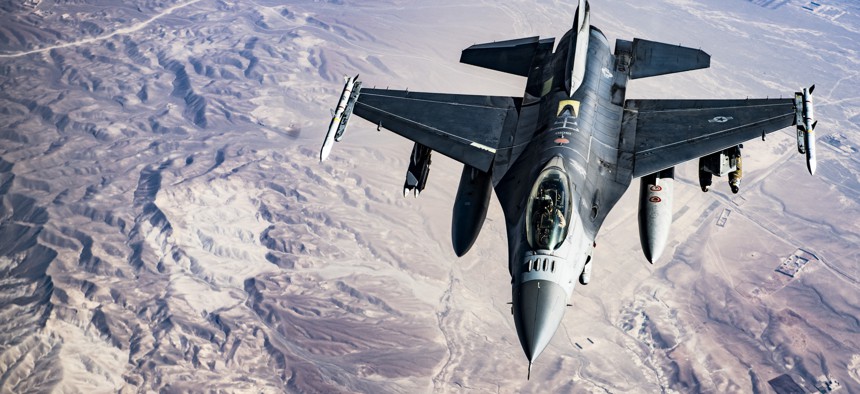
A U.S. Air Force F-16C Fighting Falcon pilot maneuvers to refuel from a KC-135 Stratotanker over Afghanistan on March 11, 2018. Air Force / Tech. Sgt. Gregory Brook
Escalating the US Air War in Afghanistan Isn’t Working
The dramatic increase in U.S. airstrikes that began last year has brought the country no closer to peace. In fact, Afghan soldiers, police, and civilians are dying at record rates.
A U.S. airstrike in the Kunduz province of Afghanistan on Saturday killed 13 civilians, the United Nations reported Monday. Ten of them were children, all from the same extended family. One day earlier, on Friday, two American soldiers were killed, also in Kunduz, both felled by small-arms fire. The Pentagon released their identities Sunday: Sgt. 1st Class Will D. Lindsay, 33, from Colorado, and Spc. Joseph P. Collette, 29, from Ohio. And though we don’t know exactly how many Afghan soldiers and police officers were killed on each of those days, as those figures are now kept secret, a New York Times report in September put their average fatalities at a shocking “30 to 40” every single day.
This is the state of Afghanistan in 2019. Civilian casualties are at a record high; U.S. troops remain in harm’s way as our air war dramatically escalates; and the United States’ longest war in history—waged at an enormous cost in blood and treasure both—has failed to achieve for Afghanistan anything resembling a stable peace.
To any outside observer, untainted by establishment Washington’s apparently indelible bias toward military intervention, the conclusion here is obvious: This isn’t working. And after nearly two decades of fighting and nation building, it should be equally obvious that it cannot work and never will. The problem here is concept, not merely execution.
Washington cannot bomb Afghanistan into America’s image or use our military to solve Afghans’ political problems. This is not so much an opinion as a summary conclusion of the last 18 years of conflict in Afghanistan under three presidents from two political parties and 18 different commanders. We’ve tried a panoply of tactics and five separate surges, with U.S. troop levels ranging from less than 10,000 to more than 100,000, with as many as 112,000 U.S. contractors to boot. In the years since the original objective of retribution for the 9/11 terrorist attacks was accomplished, we’ve tried anything and everything—everything except recognizing reality and bringing American forces home.
Related: The US Isn’t Really Leaving Syria and Afghanistan
Related: Why Withdrawing from Syria and Afghanistan Won’t Save Much Money
Related: What Will Follow a US Withdrawal from Afghanistan?
The results are grim for the United States and Afghanistan alike. "U.S. troops have made considerable sacrifices," military historian Ret. Col. Andrew Bacevich wrote three years ago in a Foreign Affairs article that remains sadly relevant. "The Pentagon has expended stupendous sums. Yet when it comes to promised results—disorder curbed, democracy promoted, human rights advanced, terrorism suppressed—the United States has precious little to show."
On top of rising casualty rates, recent years have seen the Taliban resurgent. Violence, corruption, and poverty are still widespread, and now exacerbated by drought. This generational conflict may be generously dubbed a stalemate made dangerous by unintended consequences, including radicalization of otherwise friendly or neutral populations. Kabul may kept under government control indefinitely, but that does not mean ongoing U.S. military efforts are consequential for moving Afghanistan toward peace. Another year—or 18—of tactical adjustments and command hand-offs will not change that.
This is not lost on most of the U.S. public. Complete U.S. withdrawal from Afghanistan is supported by six in 10 Americans and seven in 10 veterans, with strikingly similar support rates across major party lines. Only two in 10 Americans consider the war a success. (In our era of bitterly fractured politics, that’s practically consensus!)
Yet in Washington the consensus is rather different, and it seems to be a consensus for permanent war. “U.S. foreign policy [is] mired in the endless repetition of the movie Groundhog Day,” observes The American Conservative’s Jim Antle. “Contra George Santayana, even when we remember the past, we seem condemned to repeat it.” In Afghanistan, that repetition has prolonged beyond all reason the United States’ role in a futile, tragic conflict.
One legitimately new development of the last two years is the Trump administration’s appointment of U.S. special envoy to Afghanistan Zalmay Khalilzad, whose negotiations with the Taliban earlier this year produced a tentative framework for U.S. withdrawal. Khalilzad’s progress is good news—a diplomatic solution supported by the Afghan people themselves is the country’s best hope for a stable new order in the near future. But whether these talks come to fruition or not, the imperative of U.S. exit remains the same, because this permanent war in Afghanistan will never work. It is past time for Washington to stop pretending it will.



